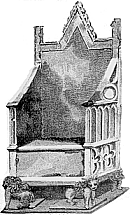 |
| Paleography
Exercises |
|
Royal
writ of 1328 (Westminster Abbey. Muniments. Coronation No.II). |
|
 |
|
It's
a very amazing thing that the editors of the series The
New Palaeographical Society knew their documents so well that every
example tells a fascinating story. They never comment on it in great detail
though. You have to think about it for yourself. This is presented as
an early 14th century royal writ under the privy
seal of Edward III, in French, displaying the type of cursive
document hand that was typical for letters of less weighty significance than charters.
It is somewhat damaged by damp and the seal has been lost. As a privy seal document, the seal should have been attached
to the face of the document. It is also a rather scruffy looking document
given the significance to history of its content. The privy seal is here
not acting as an internal conduit to the chancery,
but is dealing directly with the outside world, and with quite an august
personage. As copies of privy seal documents were not recorded on rolls,
they cannot be traced through the central administration itself, but only,
as in this case, where they have been archived by the recipients. Was
this some quiet little arrangement between gentlemen? |
|
The
writ is addressed to the abbot and convent of Westminster, and orders
them to hand over to the sheriffs of London the coronation stone of the
Scottish kings, to be returned to that country. The stone, known popularly
as the Stone of Scone, had been pillaged from Scotland by his ancestor
Edward I (after he had been sent homeward to think
again, had thought, and went back with a new plan!) It sat under
the coronation chair in Westminster Abbey, where it was part of English
coronation ceremonies, until 1996 when it was finally sent back to Scotland.
The royal writ was clearly ignored or superseded by later orders. |
|
|
The
Coronation Chair, with the Stone of Scone tucked neatly under the seat. |
|
The
origin of the stone is unknown, but like all good symbolic objects, it
has a mythic history which goes back to Biblical times. It now sits in
Edinburgh castle, and Scotland has its own House of Assembly. The Scots
now send truckloads of electrical and computer goods down into England
rather than waves of blue painted warriors in skirts, but they send some
pretty scarey supporters to football matches. Oh flower of Scotland, when
will we see your like again? |
| e. |
|
| overview | text | alphabet
| abbreviations | structure
| exercises | transcript
| translation |
|
|
Click
on each of the above to walk your way through the text. The transcript
will appear in a separate window so that you can use it for reference
at any time. These exercises are designed to guide you through the text,
not test you, so you can cheat as much as you like. |
 Script sample for this example Script sample for this example |
 Index
of Exercises Index
of Exercises |
 Index
of Scripts Index
of Scripts |
|
 |
 |

